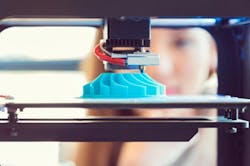Additive manufacturing/3D printing has been one of the hottest topics in manufacturing over the past several years as the technology proves its viability not only in prototyping applications, but in producing components for use in operating machinery. Though 3D printing was initially a separate, production-related step in the component design process, the trend around this technology has been toward integrating the complete additive manufacturing process into the product lifecycle, as evidenced by Proto Labs’ digital thread.
That latest news on this front is that Siemens plans to release its own “comprehensive solution … comprised of integrated design, simulation, digital manufacturing, data and process management software” in January 2017.
This release from Siemens will reportedly include Siemens’ NX CAD/CAM/CAE software, the Simcenter portfolio of simulation software and test solutions, Teamcenter lifecycle management software, Simatic IT Unified Architecture Discrete Manufacturing and Simatic WinCC HMI.
According to Siemens, a key aspect of this integrated release are two technologies that enable “automated generative design”; i.e., Convergent Modeling and topology optimization. Convergent Modeling, included in the latest release of NX, is said to help engineers optimize part design for 3D printing, speed up the overall design process and provide scan-to-print functionality, which makes reverse engineering more efficient. Topology optimization reportedly helps automate the iterative process for designing and optimizing parts to handle vibration, fluid dynamics and heat transfer. These integrated simulation and predictive engineering analytics capabilities help evaluate the design for manufacturability to provide “greater confidence needed to move forward with designs optimized for additive manufacturing.”
Siemens is also introducing new 3D print preparation software for both metal and plastic parts that will use the same smart product models from the design and simulation phase to help automate design changes and streamline the production process. The new software assists operators in preparing parts for powder bed and multi-jet fusion printing. For 3D printed metal parts, NX provides model preparation for laser metal deposition and NC programming.
Siemens adds that, for extruded materials, such as plastics and carbon fiber reinforced nylon, a new multi-axis robotic fused deposition modeling (FDM) programming technology has been developed and is currently being field tested.
Most production parts today are stamped, molded, cast or machined, Siemens says in its release announcing this integrated additive manufacturing system. “By providing engineers and designers with a completely new way to design and manufacture parts, Siemens is helping them reimagine the next generation of products. Companies can create unique, better performing designs with significantly increased strength/weight ratios and apply advanced integrated simulation and analysis technology to predict design performance. This new transformative technology will help increase design innovation.”
About the Author
David Greenfield, editor in chief
Editor in Chief

Leaders relevant to this article:
